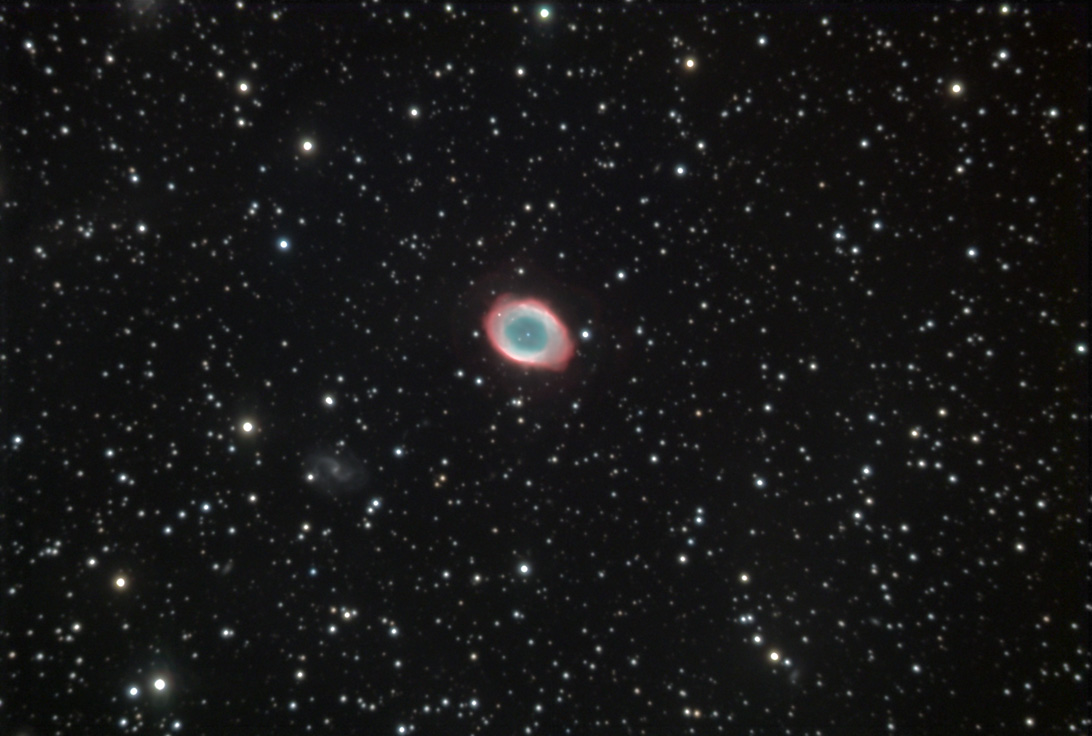M57 - The Ring Nebula

For high resolution, click here.
M57 - The Ring Nebula: The Ring Nebula is located in the constellation Lyra. It is approximately 2000 light-years away, with a central ring structure measuring about one light-year across. The nebula is illuminated by a central white dwarf of around 1.2 solar masses. Discovered in 1779, today the Ring Nebula is one of the best-known planetary nebulae.
Messier: 57
NGC: 6720
Right Ascension: 18h 53.6m
Declination: 33° 02'
Apparent Magnitude: 9.0
Date: September 2010
Equipment:
Telescope: Meade 16" Schmidt Cassegrain with f6.3 reducer
Camera: SBIG ST-10XE
Guiding: AO-8
Exposure: L: 25x5 minutes, binned 1x1
R:G:B = 9x5 minutes, binned 2x2
The camera was at -35°C
Processing Notes: Data acquisition with CCDSoft. Reduced and aligned in CCDStack. Subs combined in Sigma Combine. Arcsine stretch import of L into Photoshop. Adjusted curves and levels, reduced noise and slight Gaussian blur of the dim areas, and applied an unsharp mask. RGB combined in AstroArt at 1:1.03:1.65 ratio. Imported RGB TIFF into Photoshop, adjusted curves and levels, and applied a Carboni action "Reduce Space Noise". L was combined with RGB as a Luminance layer. No additional processing.
Scale: 0.52"/pixel on highest resolution
Links to images of this object on other sites:
http://apod.nasa.gov/apod/ap080918.html
http://messier.obspm.fr/more/m057_h2.html
http://www.noao.edu/outreach/aop/observers/m57largeblock.jpg
Additional Comments: An earlier version of M57 (from 2008) can be found here: http://www.fortlewis.edu/observatory/image_detail.asp?ID=65
A planetary nebula occurs when a sun-like star is reaching the end of its life. Typically, the star will have a core made of carbon, surrounded by a shell of helium (in the process of fusing into carbon), and outer layers of mostly Hydrogen. The fusing Helium will shrink and heat the core, attempting to fuse the carbon into heavier elements, but the temperature and pressure will never be great enough in a star of this (relatively low) mass to fuse the carbon. As a result, this very hot carbon core and helium shell drive off the outer layers of hydrogen. As these outer layers are driven off by the intense heat of the core, they form what is called a planetary nebula, that is visible as a shell of glowing gas surrounding a very hot central star. (Note that the term "planetary" has nothing to do with planets - they are called planetary because in early telescopes they appeared to be tiny fuzzy disks that reminded observers of planets!) Because the details of this shedding process can vary significantly from star to star, all planetary nebulae are unique, and many show multiple shells, as different layers are shed over a period of time. Eventually, the shell will dissipate and the hot core, now called a white dwarf, will remain. A white dwarf can have as much mass as the Sun, but compressed into a sphere the size of the Earth. For more information, try http://en.wikipedia.org/wiki/Planetary_nebula
Views: 10631
 This work is licensed under a Creative Commons Attribution-NonCommercial-ShareAlike 4.0 International License.
This work is licensed under a Creative Commons Attribution-NonCommercial-ShareAlike 4.0 International License.

